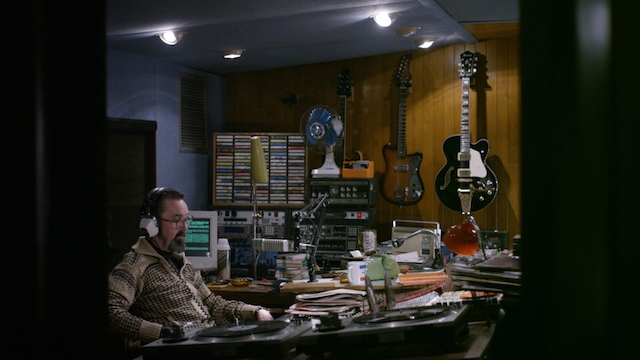Which material in the vast cache of popular media is judged to be timeless and which is discarded as ephemeral? And how does our consumption of such media structure our lived experience? The Irish artist Gerard Byrne often raises such questions in videos restaging cultural debates from magazines and newspapers that dramatise the ways in which the views of avant-garde heroes (from philosophers to science-fiction writers) fall in or out of step with contemporary mores. The video installation In Our Time (2017), commissioned for Skulptur Projekte Münster, is an uncanny mise-en-scène of an obsolescent media format: a broadcast radio station, complete with vinyl records and cassette tapes. While the installation seems more nostalgic than some of Byrne’s previous projects, it prompts viewers to consider how media formats influence social thinking.
First installed in a Münster library, In Our Time now occupies the smaller of Lisson’s two New York galleries. A single-channel rear-projected video documents Byrne’s recreation of a pop radio station’s control room, with a velvety-voiced DJ and a live band that occasionally sets up and plays a few bars. Period details – from the announcer’s oversize glasses to the record titles – date the scene’s era as the mid-1970s to the early 1980s (a period that spans Byrne’s childhood).
The gallery is a theatrical parallel to the wood-panelled radio station onscreen. Byrne has decked it out with heavy red curtains drawn against the walls, vintage speakers, a piano, sheet-music stands and freestanding microphone mounts. A nondurational work, In Our Time is structured with the cyclical cadence of 24-hour radio broadcasting. One could be fooled into thinking that the piece was a long loop, with pop music hits interrupted by repetitious commercial breaks, weather forecasts or news updates with the same stories (Reagan’s nuclear deals circa the early 1980s, and the violent death of Alberta King, the mother of Martin Luther King Jr, in 1974). Yet it becomes clear that the piece is run through an algorithm: the DJ announces the actual local time during the station breaks, even as the same material is cycled through. Furthermore, the position of viewers in the space activates additional video and audio channels. When one lingers near the piano, for example, overhead speakers play a piano-and-drum track, and the band appears onscreen. Standing underneath a speaker at the back of the space, one hears an interview with an unnamed person about buying an amp.
The pop-music offerings the DJ plays veer towards the melancholic, if not tragic, hits of the era: Femme Fatale (1967) by The Velvet Underground, Janis Joplin’s Me and Bobby McGee (1971), Iggy Pop’s The Passenger (1977). Even the choice of schmaltzy wedding ballad We’ve Only Just Begun (1970) by the Carpenters is marked by Karen Carpenter’s gloomy delivery. Between the songs, vintage ads for record stores, The Gap and a Chevrolet Camaro have the warm patina of nostalgia, even as some of them betray a sexist undertone. Their macho posturing is underscored by the announcer’s exchange with a schoolgirl caller on the line, whose voice seems to be lifted from an archived recording. As the DJ presses her to reveal the identity of her new boyfriend, the tension rises to predatory levels.
The title In Our Time links Byrne’s lifetime to the heyday of pop radio. But it also alludes to how the 24-hour broadcasting cycle is organised through advertisers’ ‘buying time’. How are memories conditioned by such commercial interruptions, and what might we lose through the disappearance of mass-media public spheres?
Scholars such as Alison Landsberg, the author of Prosthetic Memory (2004), see the potential of mass media to create collective consciousness and promote progressive politics through the work of empathy. Most historical video art, however, has been firmly rooted in Marxist tactics. Byrne’s piece is a far cry from Richard Serra and Carlota Fay Schoolman’s video-as-polemic Television Delivers People (1973), or feminist artist Martha Rosler’s videos of the 1970s and 80s deconstructing mass-media messages of torture and US foreign interventions. Yet Byrne also estranges viewers from a too-rosy view of the past. Nearly two decades into the twenty-first century, it has become clear that information silos have the potential to wreak political catastrophe. By fracturing the public sphere into niche markets, advertising can be more targeted, but public opinion can be also manipulated on issues such as Brexit. Byrne’s creation of a vintage pop radio station depicts, with ambivalence, what we stand to lose – mindless commercial breaks, perhaps, but also a sense of community.
Gerard Byrne: In Our Time at Lisson Gallery New York, 3 November – 22 December
From the January & February 2018 issue of ArtReview
